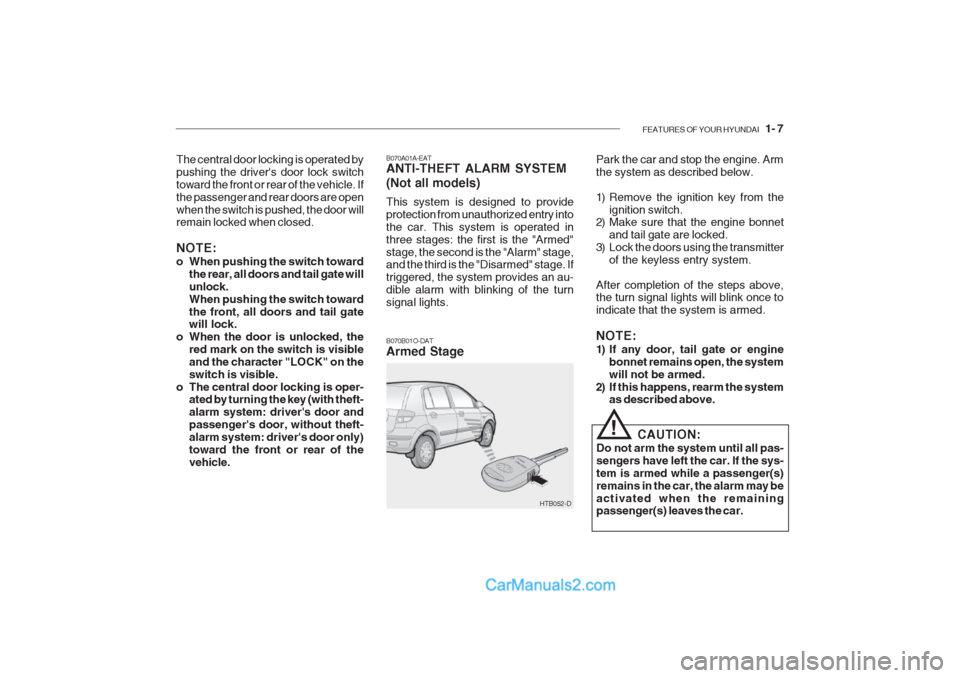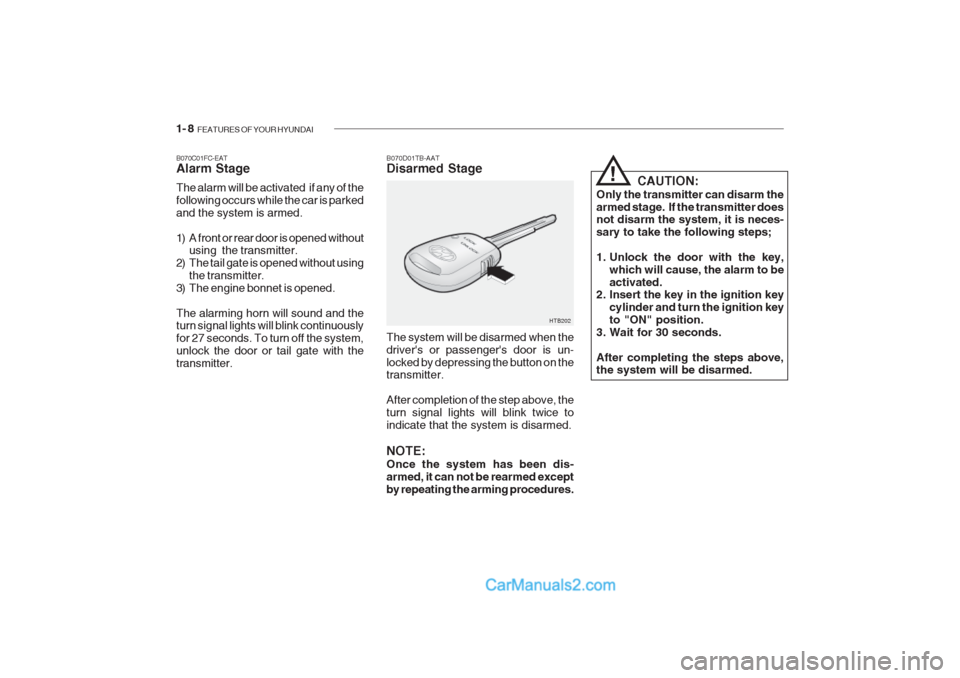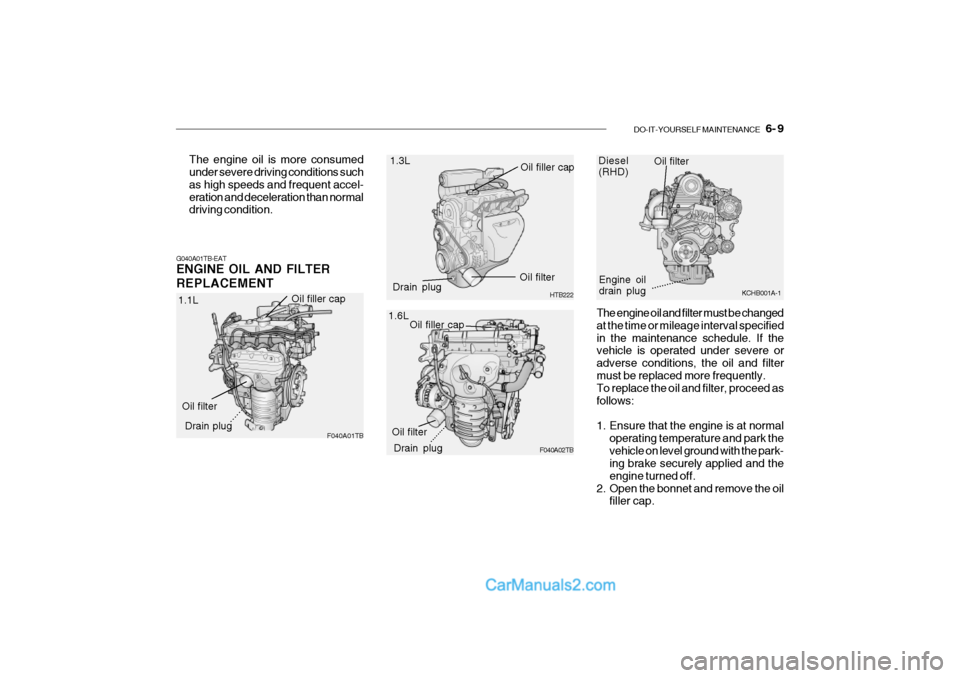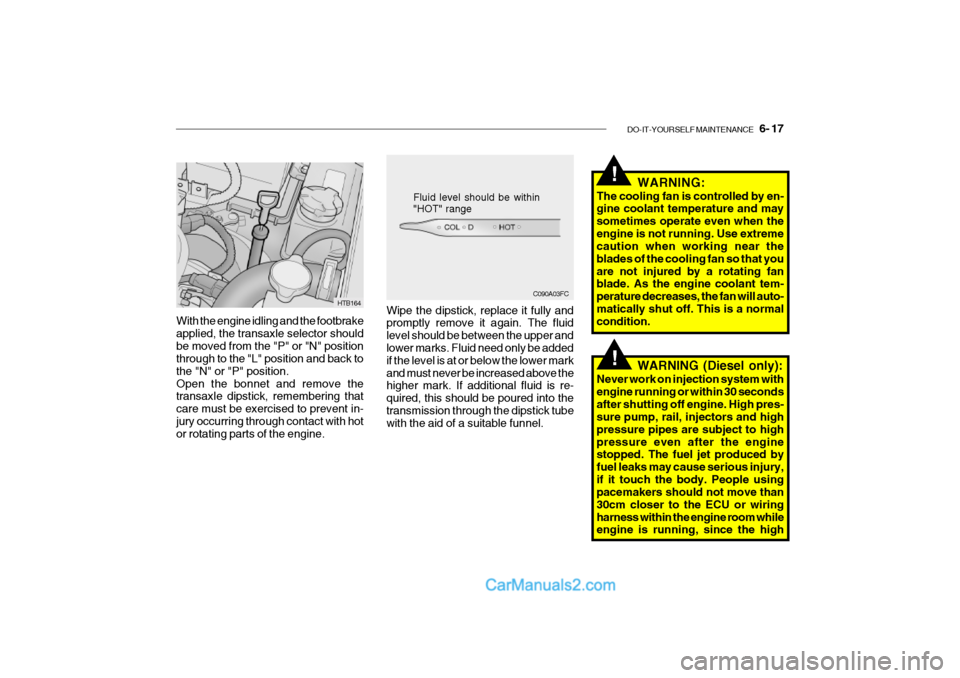2002 Hyundai Getz open bonnet
[x] Cancel search: open bonnetPage 251 of 428

FEATURES OF YOUR HYUNDAI 1- 7
B070A01A-EAT ANTI-THEFT ALARM SYSTEM (Not all models) This system is designed to provide protection from unauthorized entry intothe car. This system is operated inthree stages: the first is the "Armed"stage, the second is the "Alarm" stage, and the third is the "Disarmed" stage. If triggered, the system provides an au-dible alarm with blinking of the turnsignal lights.
The central door locking is operated bypushing the driver's door lock switchtoward the front or rear of the vehicle. Ifthe passenger and rear doors are openwhen the switch is pushed, the door will remain locked when closed. NOTE:
o When pushing the switch toward
the rear, all doors and tail gate will unlock.When pushing the switch towardthe front, all doors and tail gate will lock.
o When the door is unlocked, the red mark on the switch is visible and the character "LOCK" on theswitch is visible.
o The central door locking is oper- ated by turning the key (with theft-alarm system: driver's door andpassenger's door, without theft-alarm system: driver's door only)toward the front or rear of thevehicle. Park the car and stop the engine. Armthe system as described below.
1) Remove the ignition key from the
ignition switch.
2) Make sure that the engine bonnet
and tail gate are locked.
3) Lock the doors using the transmitter
of the keyless entry system.
After completion of the steps above, the turn signal lights will blink once to indicate that the system is armed. NOTE:
1) If any door, tail gate or engine bonnet remains open, the system will not be armed.
2) If this happens, rearm the system as described above.
CAUTION:
Do not arm the system until all pas-sengers have left the car. If the sys-tem is armed while a passenger(s)remains in the car, the alarm may beactivated when the remaining passenger(s) leaves the car.
!
HTB052-D
B070B01O-DAT Armed Stage
Page 252 of 428

1- 8 FEATURES OF YOUR HYUNDAI
HTB202
B070D01TB-AAT Disarmed Stage
B070C01FC-EATAlarm Stage The alarm will be activated if any of the following occurs while the car is parkedand the system is armed.
1) A front or rear door is opened without
using the transmitter.
2) The tail gate is opened without using the transmitter.
3) The engine bonnet is opened.The alarming horn will sound and the turn signal lights will blink continuously for 27 seconds. To turn off the system,unlock the door or tail gate with thetransmitter. The system will be disarmed when thedriver's or passenger's door is un-locked by depressing the button on the transmitter. After completion of the step above, the turn signal lights will blink twice toindicate that the system is disarmed. NOTE: Once the system has been dis- armed, it can not be rearmed exceptby repeating the arming procedures. CAUTION:
Only the transmitter can disarm thearmed stage. If the transmitter does not disarm the system, it is neces- sary to take the following steps;
1. Unlock the door with the key, which will cause, the alarm to be activated.
2. Insert the key in the ignition key
cylinder and turn the ignition keyto "ON" position.
3. Wait for 30 seconds. After completing the steps above, the system will be disarmed.
!
Page 305 of 428

FEATURES OF YOUR HYUNDAI 1- 61
SB440A1-E REMOTE FUEL FILLER LID RELEASE (Not all models) The fuel filler lid may be opened from inside the vehicle by pulling up on thefuel filler lid release.
!
HTB115-D
Before closing the bonnet, return the support rod to its clip to prevent it fromrattling. Lower the bonnet until it isabout 30 cm (1 ft.) above the closedposition and let it drop. Make sure that it locks into place.
HTB288
3. Pull the support rod from the bonnet.
HTB308
CAUTION:
Make sure that the support rod has been released prior to closing thebonnet.
4. Hold the bonnet open with the sup- port rod. WARNING:
o Always double check to be sure that the bonnet is firmly latchedbefore driving away. If it is notlatched, the bonnet could fly open while the vehicle is being driven, causing a total loss of visibility,which might result in an accident.
o The support rod must be inserted
completely into the hole providedin the bonnet whenever you in- spect the engine compartment. This will prevent the bonnet fromfalling and possibly injuring you. o Do not move the vehicle with the
bonnet in the raised position, asvision is obstructed and the bon-net could fall or be damaged.
!
Page 350 of 428

3- 4 WHAT TO DO IN AN EMERGENCY
D030A01TB-EAT IF THE ENGINE OVERHEATS If the temperature gauge indicates overheating:
1. Pull off the road and stop as soon as
it is safe to do so.
2. Place the gear selector lever in "P" (automatic), or neutral (manual transaxle) and set the parking brake. If the air conditioning is on, turn it off. 3. If coolant is running out under the
car or steam is coming out fromunder the bonnet stop the engine.Do not open the bonnet until the coolant has stopped running or the steaming has stopped. If there is novisible loss of coolant and no steam, leave the engine running and check to be sure the engine cooling fan isoperating. If the fan is not running, turn the engine off.
4. Check to see if the water pump drive belt is missing. If it is not missing,check to see that it is tight. If thedrive belt seems to be satisfactory, check for coolant leaking from the radiator, hoses or under the car. (Ifthe air conditioning had been in use, it is normal for cold water to be draining from it).
WARNING:
Whilst the engine is running, keephands and clothing away from mov-ing parts such as the fan and drive belts to prevent injury.
!
7. Remove jump cables in the reverse order of installation (black cable first).
CAUTION:
If the jump cable is incorrectly in- stalled, damage to the vehicle elec-trical system may occur, in particu- lar the electronic components such as the Fuel Injection system com-puter and the Automatic transaxle computer. The battery must never be disconnected whilst the engineis running.
!
!WARNING (Diesel only):
Never work on injection system with engine running or within 30 sec- onds after shutting off engine. Highpressure pump, rail, injectors and high pressure pipes are subject to high pressure even after the enginestopped. The fuel jet produced by fuel leaks may cause serious in- jury, if it touch the body. Peopleusing pacemakers should not move than 30cm closer to the ECU or wiring harness within the engineroom while engine is running, since the high currents in the Common Rail system produce considerablemagnetic fields.
5. If the water pump drive belt is bro- ken or coolant is leaking out, stop the engine immediately and call thenearest Hyundai dealer for assis- tance.
Page 383 of 428

DO-IT-YOURSELF MAINTENANCE 6- 9
Oil filler cap 1.3L
F040A01TB HTB222
Oil filter
Drain plug Oil filler cap
Drain plug Oil filter
1.1L
.........
The engine oil is more consumed under severe driving conditions such as high speeds and frequent accel-eration and deceleration than normal driving condition.
1.6L
F040A02TBOil filler cap
Drain plug
Oil filter
.........
Diesel (RHD)
KCHB001A-1
Engine oil drain plugOil filter................
G040A01TB-EAT ENGINE OIL AND FILTER REPLACEMENT
The engine oil and filter must be changed at the time or mileage interval specifiedin the maintenance schedule. If the vehicle is operated under severe or adverse conditions, the oil and filtermust be replaced more frequently. To replace the oil and filter, proceed as follows:
1. Ensure that the engine is at normaloperating temperature and park the vehicle on level ground with the park- ing brake securely applied and the engine turned off.
2. Open the bonnet and remove the oil filler cap.
Page 391 of 428

DO-IT-YOURSELF MAINTENANCE 6- 17
With the engine idling and the footbrake applied, the transaxle selector shouldbe moved from the "P" or "N" position through to the "L" position and back to the "N" or "P" position.Open the bonnet and remove the transaxle dipstick, remembering that care must be exercised to prevent in-jury occurring through contact with hot or rotating parts of the engine.
C090A03FC
Fluid level should be within "HOT" range
HTB164 Wipe the dipstick, replace it fully and promptly remove it again. The fluid level should be between the upper and lower marks. Fluid need only be added if the level is at or below the lower markand must never be increased above the higher mark. If additional fluid is re- quired, this should be poured into thetransmission through the dipstick tube with the aid of a suitable funnel. WARNING:
The cooling fan is controlled by en-gine coolant temperature and may sometimes operate even when theengine is not running. Use extreme caution when working near the blades of the cooling fan so that youare not injured by a rotating fan blade. As the engine coolant tem- perature decreases, the fan will auto-matically shut off. This is a normal condition.
!
!WARNING (Diesel only):
Never work on injection system with engine running or within 30 secondsafter shutting off engine. High pres- sure pump, rail, injectors and high pressure pipes are subject to highpressure even after the engine stopped. The fuel jet produced by fuel leaks may cause serious injury,if it touch the body. People using pacemakers should not move than 30cm closer to the ECU or wiringharness within the engine room while engine is running, since the high
Page 394 of 428

6- 20 DO-IT-YOURSELF MAINTENANCE
B145A01TB-EAT CHANGING THE POLLEN FIL-
TER (In Front of evaporator unit)(Not all models) The pollen filter is located in front of the evaporator unit behind the glove box. It operates to decrease pollutants fromentering the car and to filter the air.
1. Remove the adjusting pins on both
sides of the glove box to open half the glove box.
HTB290-D
SG140D1-E Off Season Maintenance The air conditioning must be run for ten minutes or so weekly during periodswhen the system would not normally be used to ensure that the compressor and seals are lubricated. If this precautionis not observed the compressor seals may become stuck to the compressor shaft and damaged when the system isnext used resulting in a loss of refriger- ant and damage to the compressor.
SG140C1-E Checking the Refrigerant
1. Start the engine and run at idle for
several minutes with the refrigera- tion system running at the coldest setting.
2. Open the bonnet and inspect the sight glass on the top of the receiverdryer.
3. If the refrigerant charge is insuffi- cient, a flow of bubbles will be ob-served through the sight glass.
4. If the refrigerant charge is satisfac- tory, no bubbles will be observedthrough the sight glass. CAUTION:
Running the air conditioning systemwith a low refrigerant level may dam-age the compressor.
!
The air conditioning compressor drive belt should be checked to ensure free- dom from damage or excessive wearand correct tension. The belt tension is correct when the belt deflects by about 0.3 inches (8 mm) (1.1L: 5 ~ 5.5 mm)when a force of 98 N is applied to the belt halfway between the compressor and crankshaft pulleys. Adjustment ofthe belt should be entrusted to a Hyundai dealer.